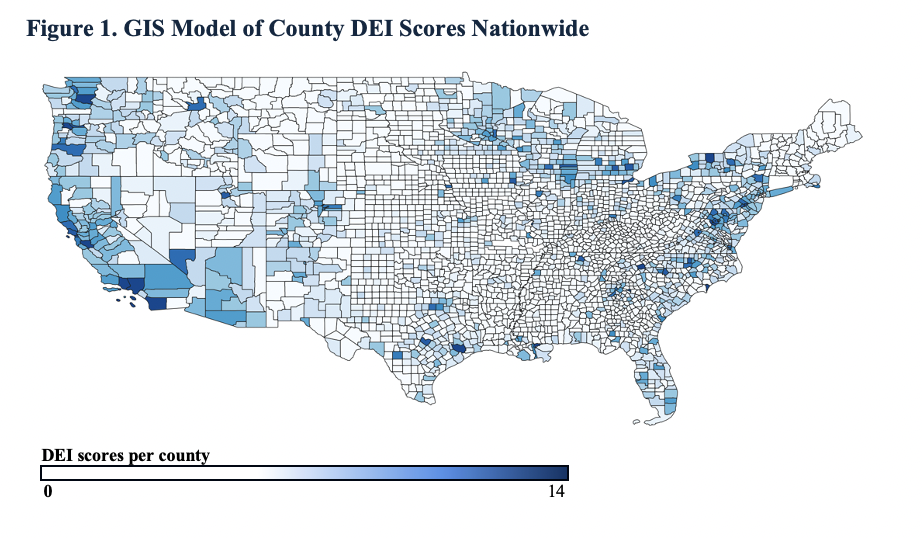Widgetized Section
Go to Admin » Appearance » Widgets » and move Gabfire Widget: Social into that MastheadOverlay zone
What’s Happening With County Government and Dei?
The views expressed are those of the author and do not necessarily reflect the views of ASPA as an organization.
By John M. South
November 1, 2024

To what degree are American counties embracing or eschewing efforts to encourage Diversity, Equity and Inclusion (DEI)? One way to get an answer to this important question has been to conduct a study of the websites for all 3,143 county websites in the United States.
The theory behind this work was that if a county was open to discussing the social aspects of DEI, then its official website would advertise these tendencies. Only social aspects of three terms were recognized in this analysis: “diversity,” “equity” and “inclusion.” It is worth noting that verbiage pertaining to bio-diversity, financial equity or legalese mentioning ‘inclusion into the record’ was not considered.
We carefully scoured the websites to answer the following questions:
- Was there any mention of any kind on the website of DEI?
- Could a hyperlink to this information be found on the home page?
- Was the link to the information available within one or two clicks of the home page?
- Did the website include a mission statement or a vision of DEI in the future?
- Were there any DEI policies of any kind illuminated?
- Was there any mention of history of race relations?
Though it may appear that DEI is an extremely hot topic in state and local government, when home pages of the counties were examined, very few had home page hyperlinks leading to efforts utilizing those terms. In fact, only 1.3 percent of counties had a major DEI hyperlink on their official website, while 37.6 percent of all U.S. counties had at least one mention of the topic on their sites.
The study endeavored to answer questions:
- Did bigger counties with larger budgets have higher DEI scores on the rating system built from the criteria listed above?
- Would partisan leanings of both the state and county impact DEI scores?
- To what degree would geography impact DEI scores?
- Would more diverse counties will have higher DEI scores?
The answers were pretty clear. Regression models showed that there was statistical evidence of higher DEI scores being associated with heavily populated counties. It’s a reasonable guess that larger counties would tend to have the resources necessary to fund a DEI program, and that this would be reflected on the county websites.
Similarly, higher DEI scores were also correlated with state politics, as counties within politically progressive states (based on the make-up of state legislatures and historical voting pattern) tended to be more apt to advertise DEI on their websites. Clearly, progressive ideologies tend embrace DEI, while conservative ideologies tend to eschew aspects of DEI.
Overall, diversity of counties had some statistical significance as well, as hundreds of small rural counties that were mostly white often did not discuss any DEI at all on their websites. This wasn’t a great surprise, as the issues of diversity equity and inclusion aren’t nearly as pertinent in places that aren’t diverse as in others that are.
Two unexpected findings revealed that lower DEI scores were associated with higher county populations of both women and African Americans. Finally, state senate (higher chamber) majority also impacted DEI scores as blue states typically saw higher DEI sores for its counties. However, these scores were shown to be slightly reduced if the higher chamber majority and governor were both blue. What’s more? Having a higher Hispanic populated was correlated with higher DEI scores.
Another approach taken to analyze the data was to create a GIS model and that yielded interesting results as well, beyond showing the geographic areas that have the highest DEI scores based on this research. The map (Figure 1) shows heavily shaded regions for counties that had the highest DEI scores. Counties with no shading had no score.
The results reveal two important findings. First, it is readily apparent that the idea of ‘leakage’ is occurring across the nation, as counties neighboring counties with the darkest shades have shading themselves, albeit not as dark. Put another way the counties with the darkest shades (and highest scores) are surrounded by counties with significant shading as well.
Second, the darkest shaded counties lie over the major metropolitan areas of the country. Thus, it is evident that more populated, urban cities are progressively discussing DEI on their respective county government websites. The inverse is also true, as major swaths of white (representing an overall DEI score of zero) sweep across the central plains and throughout the Midwest, where hundreds of small, rural counties exist.
This research is important for three reasons. First, it explores ramifications of DEI on county government (a level of government that is not researched much in the current literature). Second, with the controversy surrounding DEI on the national political landscape, inspecting how locally elected officials navigate the difficulties associated with DEI only adds to depth of current literature. Finally, this research opens the door for follow-on research of DEI in county government as interviews and focus groups of professional public servants could help identify more reasons why some counties fully embrace DEI while other counties do not.
Author: Dr. John M. South received his PhD in International and Public Affairs from Florida International University. He has an MPA from FIU as well. He is a current ASPA Founders Fellow and current Presidential Management Fellow. He works for the Centers for Disease Control and Prevention in Atlanta.” This article was written under the auspices of Barrett and Greene, Inc.
Political influences from the state AND county level. Let’s leave it at four for this article.


Follow Us!